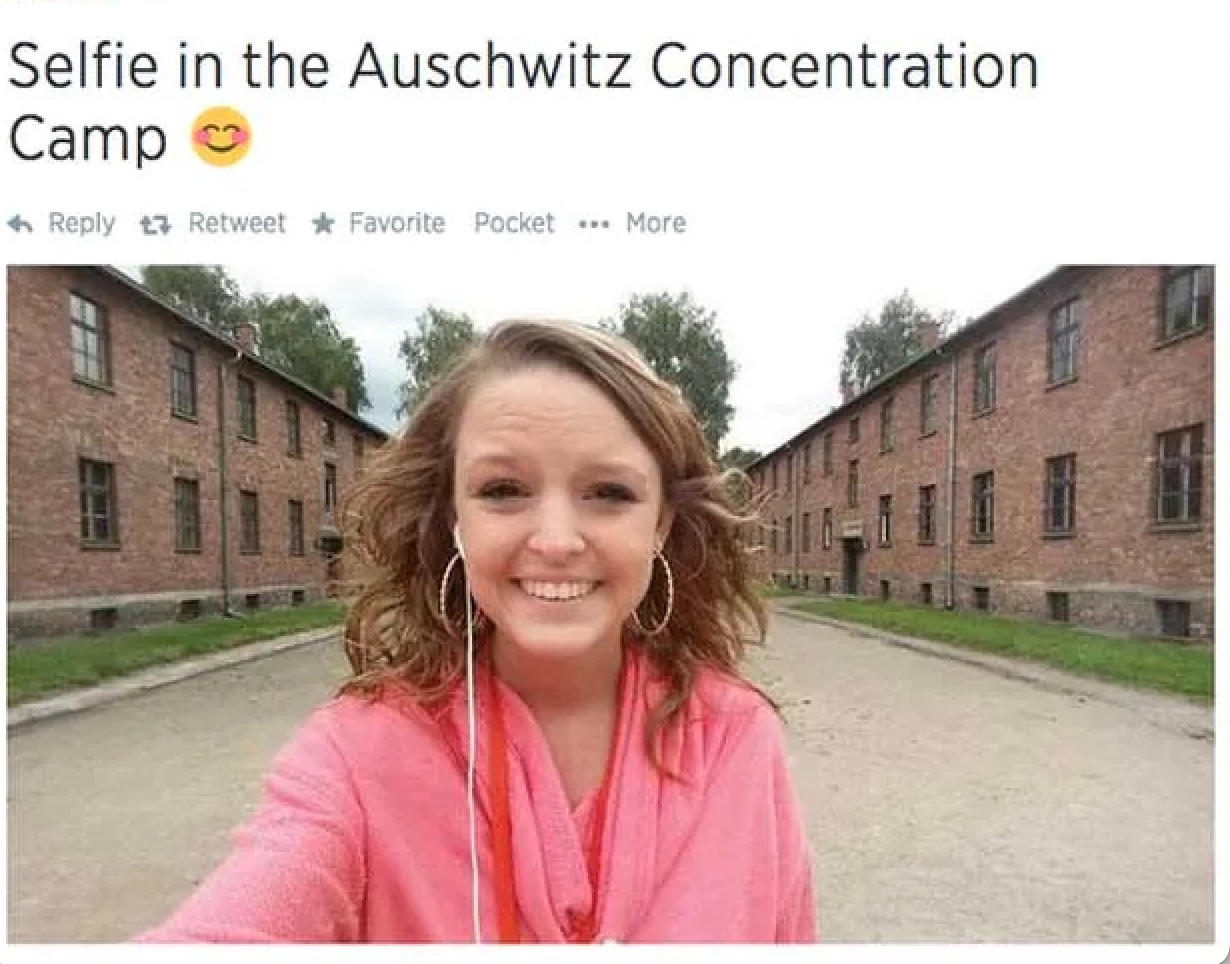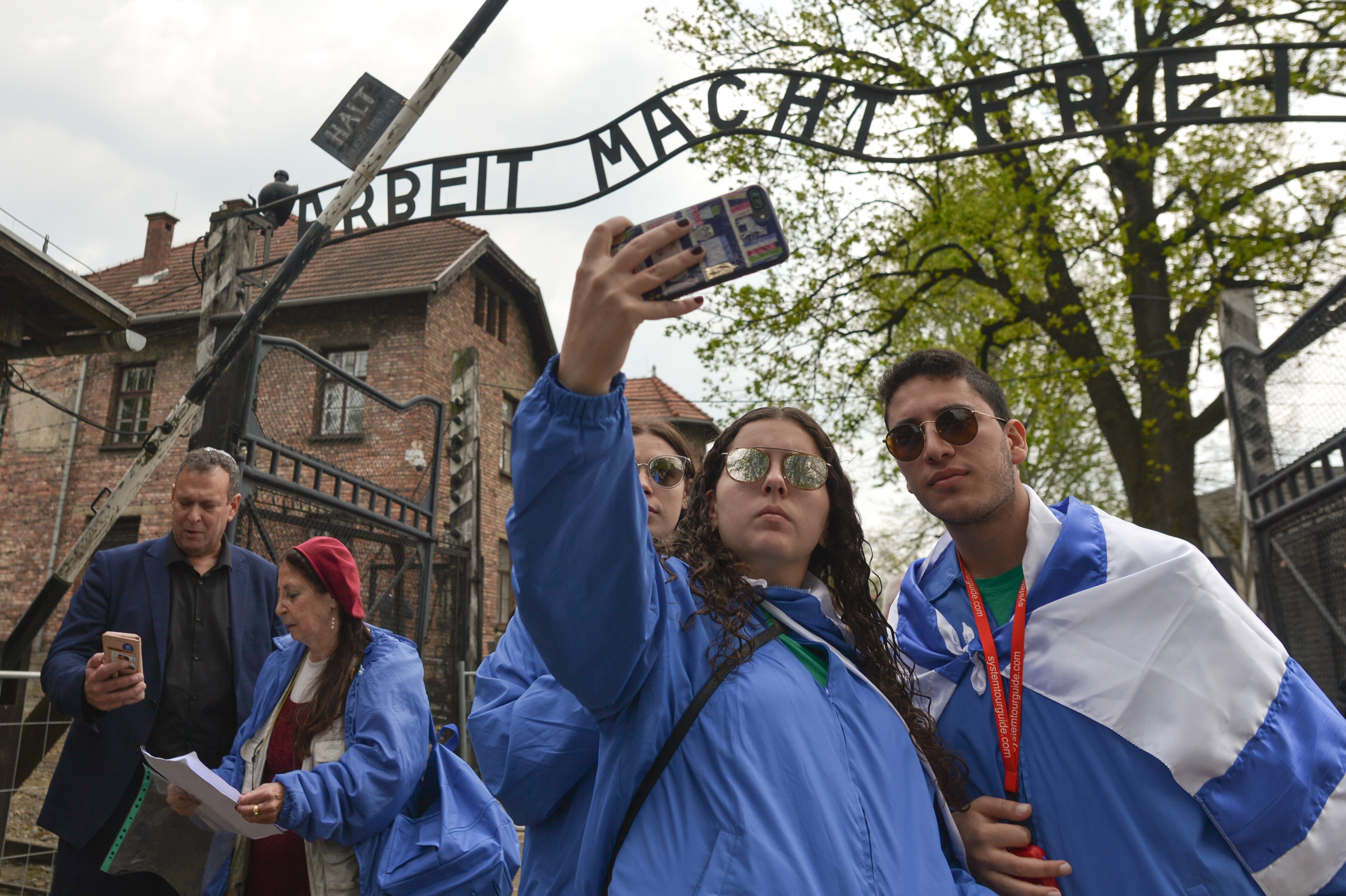One day in 2014, a recent high school graduate from eastern Alabama snapped a selfie—earbud dangling from one ear, pink jumper on, hoop earrings in—and uploaded it to her personal Twitter account. It seemed utterly normal and innocuous.
And it would have been, if not for the ground the blonde teenager was standing on: Auschwitz—the notorious extermination camp where 1.1 million men, women, and children were murdered from 1940 until liberation on January 27, 1945.
The online backlash was swift and furious, with the original post garnering thousands of retweets and comments from an outraged Internet.

“Did you manage to take any of you laughing inside a gas chamber or maybe one with your head stuck in a cremator?” one Twitter user responded.
“How can you be happy and smile in this pic? Do you not understand the horrors and murders that happened here?” another asked.
To many, her transgression might seem obvious. “Don’t take selfies where genocide was perpetrated” feels like a rule no one should have to state out loud. But the resulting furor, on social media and in the press, shows that the issue is more widespread than you’d think, and perhaps less cut and dried.
In the ensuing weeks and months, for example, an Israeli Facebook page, loosely translated as “With My Besties in Auschwitz,” culled real-life photos of Israeli kids on school trips to Poland—many of them featuring selfies under the epigraph Arbeit macht frei or “Work sets you free.” The page and photos subsequently were taken down, but their existence was written up in The New Yorker.
Meanwhile, the Auschwitz Museum has tweeted out countless pleas over the years for visitors to quit using their time on the grounds as “content” for their social media accounts.
“When you come to @AuschwitzMuseum remember you are at the site where over 1 million people were killed. Respect their memory. There are better places to learn how to walk on a balance beam than the site which symbolizes deportation of hundreds of thousands to their deaths,” museum officials tweeted in 2019.
What Is It About Selfies?
There can be no more controversial form of photography today than the selfie. To some sociologists and social media theorists, they’re a code for self-absorption and narcissism. To others, they serve a different purpose; psychologist Barry Gunter described them as “a social currency that maintains and reinforces friendships, a feedback loop for self-identity affirmation, a promotional tool for gaining social influence, and a method for preserving memories of life events.”
Regardless, wrote Caitlin Dewey in the Washington Post, “it’s hard to think of anything less sensitive, less appropriate or less self-aware than a ‘selfie’ in the Auschwitz Concentration Camp.’”
Are all these selfie-takers simply insensitive narcissists? Possibly! But their behavior may also be related to the passage of time and the teaching of history. While the Holocaust may feel like the recent past to older generations, to younger generations it feels like ancient history. The dwindling population of people who lived through World War II makes the horrors ever more inaccessible.
(Perhaps that’s why places such as Tuol Sleng, Cambodia, or the Nyamata Genocide Memorial Centre in Rwanda, haven’t attracted the same type of behavior: Their horrors are more recent, more present.)
And clearly, lack of history education is a factor. In the U.S., a 2020 nationwide survey, led by a task force of Holocaust survivors, historians, museum experts, and educational institutions including Yad Vashem, the United States Holocaust Memorial Museum, the Claims Conference, and George Washington University, revealed a growing disconnect between education and disinformation online.
In 1,000 interviews conducted nationwide, with 200 interviews in each state, the survey found that “63 percent of all national survey respondents do not know that six million Jews were murdered and 36 percent thought that ‘two million or fewer Jews’ were killed during the Holocaust. Additionally, although there were more than 40,000 camps and ghettos in Europe during the Holocaust, 48 percent of national survey respondents cannot name a single one,” the survey found.
Even more worrisome is that of the adults polled, ages 18 to 39, 11 percent of millennials and Gen Zers incorrectly responded that they believed the Jews caused the Holocaust.
That disconnect was on full display once again when a 2020 TikTok trend drew the ire of many, as users—mostly teens—were found to be uploading clips of themselves participating in what was dubbed the #holocaustchallenge. In the brief clips, users can be seen portraying Holocaust victims—painting fake bruises on their faces and wearing clothes that Jewish prisoners were forced to wear by Nazi guards.
One TikTok user, her face painted ghostly white, could be seen saying, “I died by gas chambers in Auschwitz.” Another, with faux bruises on her face, wrote “yeah, so i died in the holocaust, 1941.”
🤮😷this is kyla.atkin pic.twitter.com/RGIoCvN4iB
— Patricia ✡︎ 🏳️🌈 ⚢ (@Mowgli_Lincoln) August 18, 2020
Are Selfies Ever Appropriate?
It may seem crazy to ask, but in the face of changing norms, other Holocaust memorials around Europe are re-evaluating their attitudes and in some cases, embracing the new era.
“’Selfies’ are a part of today’s cultural experience and the virtualization of the world,” Günter Morsch, a former director of the Sachsenhausen Memorial and Museum, told ABC News. “In the virtual world, people try to integrate an authentic place into part of their own image and that’s actually something positive.”
Berlin’s Memorial to the Murdered Jews of Europe—a 4.5-acre site covered with 2,711 tomb-like concrete slabs—is another such place that is open to new interpretations.
Peter Eisenman, the New York City–based architect who designed the memorial, wrote that the concept of this monument is that “there is no goal, no end, no working one’s way in or out. The duration of an individual’s experience of it grants no further understanding, since understanding the Holocaust is impossible. The time of the monument, its duration from top surface to ground, is disjoined from the time of experience. In this context, there is no nostalgia, no memory of the past, only the living memory of the individual experience.”
Eisenman caused a stir when, in 2005, he suggested that the memorial be integrated into the city’s infrastructure, allowing people to have picnics at the stones and the like.
Integration is one thing; a full fashion shoot, however, is another.
In 2009, the budget airline easyJet was forced to withdraw almost 300,000 copies of its in-flight magazine after they received complaints of that one of its articles, “A Quick Guide to the Chic Side of Berlin,” was showcasing models posing within the concrete slabs of the Berlin memorial. The accompanying article stated: “Ravaged by war and torn in two by conflicting ideologies, Berlin may not be a picture-perfect jewel … but it’s a treasure trove for the culture vulture … no visit would be complete without exploring the testaments to the city’s turbulent past, such as … the Jewish Museum and the Holocaust memorial.”
Uwe Neumärer, a spokesman for the Foundation for the Memorial to the Murdered Jews of Europe, told The Guardian he hadn’t authorized the shoot. “We only give permission to projects that have a connection to the memorial, the Holocaust or some aspect of commemoration,” he said.
Still, among those who work at and maintain the Berlin memorial, the view is that selfies are less of a trivialization of history, and more of how a younger generation engages with it.
“We don’t forbid selfies, but if someone is doing a pose a little too much in the direction of too flashy, employees might mention to the person that this is perhaps not the right place for it while explaining what the memorial represents,” Felizitas Borzym, a spokesperson for the memorial, told ABC News.
This type of dialogue, Borzym said, is effective.
“People should explore the location with selfies as a person with their phone. To have photos of themselves in the location is really the way young people experience this memorial.”





